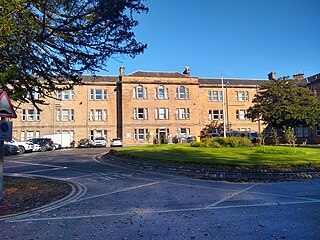
Plastic surgery is a surgical specialty involving the restoration, reconstruction, or alteration of the human body. It can be divided into two main categories: reconstructive surgery and cosmetic surgery. Reconstructive surgery includes craniofacial surgery, hand surgery, microsurgery, and the treatment of burns. While reconstructive surgery aims to reconstruct a part of the body or improve its functioning, cosmetic surgery aims at improving the appearance of it.

East Grinstead is a town in West Sussex, England, near the East Sussex, Surrey, and Kent borders, 27 miles (43 km) south of London, 21 miles (34 km) northeast of Brighton, and 38 miles (61 km) northeast of the county town of Chichester. The civil parish has an area of 2,443.45 hectares. The population at the 2011 Census was 26,383.
Sir Harold Delf Gillies was a New Zealand-born British otolaryngologist and father of modern plastic surgery.
The Guinea Pig Club, established in 1941, was a social club and mutual support network for British and allied aircrew injured during World War II. Its membership was made up of patients of Archibald McIndoe in Ward III at Queen Victoria Hospital, East Grinstead, Sussex, who had undergone experimental reconstructive plastic surgery, including facial reconstruction, generally after receiving burns injuries in aircraft. The club remained active after the end of the war, and its annual reunion meetings continued until 2007.

Sir Archibald Hector McIndoe was a New Zealand plastic surgeon who worked for the Royal Air Force during the Second World War. He improved the treatment and rehabilitation of badly burned aircrew.

The Queen Victoria Hospital (QVH), located in East Grinstead, West Sussex, England is the specialist reconstructive surgery centre for the south east of England, and also provides services at clinics across the region. It has become world-famous for its pioneering burns and plastic surgery. The hospital was named after Queen Victoria. It is managed by the Queen Victoria Hospital NHS Foundation Trust.

The Royal Edinburgh Hospital is a psychiatric hospital in Morningside Place, Edinburgh, Scotland. It is managed by NHS Lothian.
George Thomas Hine FRIBA was an English architect. His prolific output included new county asylums for Hertfordshire, Lincolnshire, Surrey, East Sussex and Worcestershire, as well as extensive additions to many others.
George Herman Bennions, DFC, nicknamed "Ben", was one of the leading Battle of Britain Spitfire pilots.
Albert Ross Tilley, was a Canadian plastic surgeon who pioneered the treatment of burned airmen during the Second World War.

West London NHS Trust is an NHS trust which provides mental and physical health services to the London boroughs of Ealing, Hammersmith and Fulham and Hounslow. It also provides some services on a national basis, including forensic and high-security services.

Middlemore Hospital is a major public hospital in the suburb of Otahuhu, Auckland, New Zealand. The hospital has approximately 800 beds. There are 24 operating theatres across two sites.

St Luke's Hospital was a psychiatric hospital in Middlesbrough, North Yorkshire, England. It was managed by Tees, Esk and Wear Valleys Foundation NHS Trust.

Grantham and District Hospital, is an NHS hospital in Grantham, Lincolnshire, England. It is managed by United Lincolnshire Hospitals NHS Trust.

St Nicholas Hospital is an NHS psychiatric hospital located in Gosforth, Newcastle upon Tyne, England, UK. The entrance is located on Jubilee Road. The buildings range from Victorian-era to modern facilities and occupies 12 hectares of land. It is managed by Cumbria, Northumberland, Tyne and Wear NHS Foundation Trust.

Air Vice Marshal Harold Arthur Cooper "Birdie" Bird-Wilson, was a senior Royal Air Force officer, and a flying ace of the Second World War.

Napsbury Hospital was a mental health facility near London Colney in Hertfordshire. It had two sister institutions, Harperbury Hospital and Shenley Hospital, within a few miles of its location.

Prestwich Hospital is a mental health facility at Prestwich in Greater Manchester. There is still a low secure unit on site managed by the Greater Manchester Mental Health NHS Foundation Trust.

Mary Evelyn Lentaigne is a British former medical artist and Red Cross Voluntary Aid Detachment nurse who worked at the Queen Victoria Hospital, England, during the Second World War. She is known for the drawings she made there of the surgical procedures of New Zealand plastic surgeon Archibald McIndoe who was working on injured servicemen. Around 300 of her drawings are held by the East Grinstead Museum where they form the Mollie Lentaigne Collection.
Ian Fraser Muir MBE, FRCS, FRCSEd was an English plastic surgeon at the West Middlesex Hospital and Mount Vernon Centre for Plastic Surgery. While working there he developed what became known as the 'Muir and Barclay formula' which estimates the volume of fluid replacement required in the initial resuscitation after major burns. In 1969, he relocated to Aberdeen to set up the plastic surgery and burns unit, having been appointed plastic surgeon and senior lecturer in Surgery at the University of Aberdeen. He was elected president of the British Association of Plastic Surgeons
















